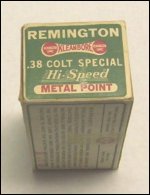There is no comparison between the .38-44 and .44-40. While looking similar (the nomenclature) they mean two entirely different things.
In the case of the .38-44 it is a high velocity of a standard .38 Special cartridge intended for S&W "Heavy Frame" (N Frame, .44 size) revolvers. The .38 Special was from the beginning, and always has basically been a revolver cartridge.
The .44-40, nominally .44 Cal. bullet and 40 grains of Black Powder, was designed as, and always has been, a rifle cartridge for which several handguns were later adapted to use this cartridge. The .44-40 (.44 W.C.F.) was originally designed for the Winchester Model 1873. The cartridge (and the later .38-40) were designed originally as a straight taper, not bottleneck, case to facilitate feeding in the 1873 action. The cartridge case was a straight taper, the chamber was bottlenecked. The same situation applied to the .38-40 and .32-20. All three cartridges were originally for the Model 1873. It wasn't until sometime after smokeless powder came to be commonly loaded in the 1873 series of cartridges that the cartridge began to be formed as a bottleneck.
It is an entirely different subject to explain why a .423" to .431" diameter bullet is called a .44. Likewise why a .38 Cal. uses a .357 bullet. And on, and on, and on..........









